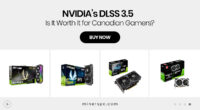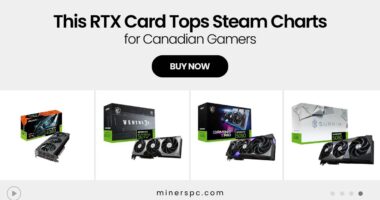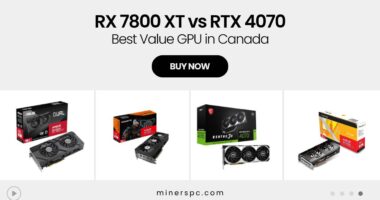Whether you’re a digital artist pushing pixels in 4K, a content creator editing hours of footage, or a streamer juggling OBS, Discord, and triple-A games—all on one machine—your GPU matters. In today’s creative landscape, especially here in Canada where reliable performance is key and upgrade cycles aren’t taken lightly, choosing the right NVIDIA graphics card can be the difference between frustration and flow.
This guide will break down exactly what Canadian creators and streamers should consider when selecting their next NVIDIA GPU—and which models are excelling in 2025.
Understanding Your Workflow: Creation vs. Streaming
Before diving into product comparisons, let’s clarify the difference in GPU demands between content creation and streaming.
- Video editors and 3D artists using Adobe Premiere Pro, Blender, DaVinci Resolve, or Autodesk tools need strong CUDA performance, VRAM headroom, and fast encoding capabilities.
- Streamers, on the other hand, benefit most from NVENC support (NVIDIA’s encoder tech), solid thermals, and the ability to multitask across demanding titles and software.
Canadian creators in cities like Toronto, Vancouver, and Montreal often need a card that can handle both—and thankfully, NVIDIA has designed its lineup with this exact versatility in mind.
Entry-Level Picks for Beginners and Light Workflows
If you’re just starting out with video editing, hobbyist streaming, or light graphic design, you don’t need to overinvest—yet. An entry-level card will give you the boost you need without overkill.
MSI Gaming GeForce GT 1030 4GB
Ideal for photo editing, light 1080p video rendering, or using OBS Studio at lower settings, the GT 1030 is a quiet, low-power option perfect for basic creator tasks or secondary streaming machines.
MSI Gaming GeForce GTX 1650 4GB GDDR6
With NVENC encoding and better support for hardware-accelerated tasks, the GTX 1650 is great for entry-level streamers using platforms like Twitch or YouTube. It handles most older titles and indie games smoothly at 1080p, making it ideal for Canadian newcomers on a tight budget.
Mid-Tier GPUs: The Sweet Spot for Most Creators
For serious editors, 2D/3D designers, or streamers running OBS with gameplay at 1080p or 1440p, mid-tier GPUs strike the ideal balance between performance and cost-effectiveness.
ZOTAC Gaming GeForce RTX 3050 Twin Edge OC 8GB
This card supports DLSS and ray tracing and includes a powerful NVENC encoder for smooth streaming. Its IceStorm 2.0 cooling keeps thermals under control, which is particularly helpful for creators working in smaller setups or less-ventilated Canadian apartments.
ASUS Dual GeForce RTX 3060 OC Edition 8GB
With 8GB of GDDR6 VRAM and enhanced encoding power, the RTX 3060 remains one of the most popular choices for creators in 2025. It can tackle real-time video rendering, stream demanding titles like Warzone or Valorant, and keep up with multi-monitor workflows. Great for Canadian YouTubers or TikTok editors pushing out content weekly.
GIGABYTE RTX 3060 Gaming OC 12GB
The added VRAM makes this card a solid choice for 4K timelines in Adobe Premiere or handling larger textures in Blender. Three WINDFORCE fans also mean excellent cooling, which is a must if you’re running long render sessions during cold Alberta winters—or warm British Columbia summers.
Upper-Mid Tier: More Power, More Possibilities
If you’re editing RAW 6K footage, doing 3D animation, or streaming modern games at ultra settings with overlays, alerts, and webcams all running—this is your range.
ZOTAC Gaming GeForce RTX 3060 Twin Edge OC 12GB
With its OC boost and advanced cooling system, this GPU delivers consistent performance in high-stress situations. It’s a strong option for Canadian creators who want dependable power but aren’t ready to jump to flagship-tier pricing.
ASUS Dual GeForce RTX 3060 V2 OC Edition 12GB
The dual-slot design makes it ideal for compact creator rigs. And with 12GB of memory, it’s capable of real-time 4K playback in video editing software—cutting down on preview lag and rendering times.
Expert Tip: Don’t Forget the Software Stack
The card you choose should match the software you use most often. Adobe Suite, OBS, DaVinci, and Blender all benefit from NVIDIA GPU acceleration. And if you stream or export a lot, NVIDIA’s NVENC encoder will save you countless hours compared to CPU-only rendering.
As a creator in Canada, where power bills can vary by province and studio space isn’t always expansive, thermal design and power efficiency should also be key considerations. Models like the ZOTAC RTX 3050 Twin Edge or MSI GTX 1650 Ventus XS keep noise and heat low without sacrificing performance—perfect for long creative sessions in tight spaces.
Real Canadian Use Case: Building a Flexible Editing + Streaming Rig
Let’s take Lisa, a freelance video editor and part-time Twitch streamer in Ottawa. She edits wedding videos in DaVinci Resolve and occasionally streams cozy games like Stardew Valley.
Her build?
An ASUS Dual RTX 3060 OC Edition 12GB, paired with 32GB of RAM and an AMD Ryzen CPU. This setup gives her smooth 4K editing previews, fast exports with NVENC, and lag-free OBS streaming—all from one machine.
Cards like this are the backbone of countless creative rigs across Canada, from solo creators in Calgary to production houses in Toronto.
Final Thoughts: Invest Smart, Create More
For Canadian creators and streamers, a well-chosen NVIDIA GPU isn’t just a piece of hardware—it’s a workflow multiplier. From encoding faster exports to rendering smoother timelines and keeping streams flawless, the right card lets you do more in less time, with less stress.
And as AI-enhanced tools continue to evolve in creative apps, the power of RTX cards is only becoming more valuable.
















![Best Prebuilt PCs in Canada for Work, School & Gaming [2025 Guide]](https://www.minerspc.com/wp-content/uploads/2025/07/best-prebuilt-pcs-in-canada-for-work-school-gaming-2025-guide-260x140.jpg)


